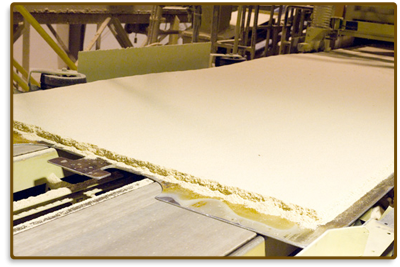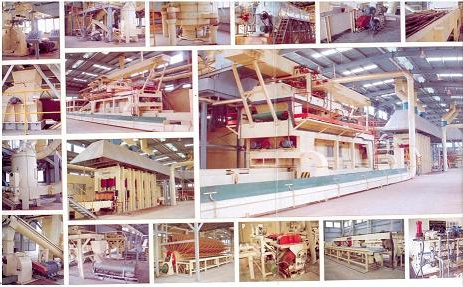
In the race for profit, many novice businessmen rely on the manufacture of modern materials forIn the majority of cases, manufacturers do not pay attention to such products as chipboard. They consider it an outdated option. Some people refer to the manufacture of this material as one of the ways of recycling.
Particleboard stands for wood chipboard. It is a composite sheet material. Particleboard production is carried out by the method of hot pressing of woodworking waste, mainly sawdust, shavings. To obtain special properties, special additives are included in the composition. Their volume is from 6 to 8 percent of the mass of the main filler.
Application area
The scope of use of chipboard is very wide. This material is used in decoration and construction, in the manufacture of furniture and doors. In addition, chipboard is used in carriage building and automotive industry. Today, the most widely used chipboard in the manufacture of furniture.
Particleboard manufacturing plant is a profitable business. It is especially good if there is access to cheap raw materials - woodworking waste. However - depending on the available capital - you can organize a small production of chipboard. Demand in the construction market for this material is constant. Therefore, with the sale of products there will be no problems.
Technology
Particleboard is made by hot pressing, using wood shavings as the main raw material, with the addition of thermosetting resin. It looks pretty simple. Particleboard production requires high-grade raw material - any inexpensive wood. Sawdust, wood chips and recycled wood can also be used. The presence of antiseptic, water-repellent and other additives determines the durability and strength of the material.
Particleboard production is carried out according to a rather simple scheme:
- The chips are mixed with a thermosetting resin.
- Then the prepared mass is filled with specially prepared forms.
- After that, under the influence of high pressure and increased temperature, the technological mixture is glued together.
- The made plate is taken out of the mold, cooled, sanded and the edges are worked.
The whole process of chipboard production is divided into the following stages:
- preparation of raw materials;
- production of technological mass;
- filling out forms and forming a carpet;
- pressing and gluing of plates;
- cooling and trimming products to size;
- grinding of planes and ends.
If imported material is used, there is no need to carry out the first two stages. Otherwise, you need to purchase a special crusher or grinding machine, which requires additional costs.

Equipment price
The cost of the crusher, depending on the capacity and manufacturer of the installation, ranges from 160,000 to 460,000 rubles. The price of a chip machine is about 1280,000 rubles. Such costs are not considered large at the time of creation of this production. However, it does not hinder to think well and organize the supply of finished raw materials from enterprises in the woodworking industry.
Particleboard manufacturing process
- Preparation of the technological mixture of chips with adhesive is carried out in a mixer intended for this purpose. This is an important equipment for the production of chipboard. In such installations, shavings and heated resin are supplied. In addition, hardeners are added to the mixture.When preparing the process mass, it is necessary to correctly monitor the proportions of the components that make up its composition. The quality characteristics of the material depend on these ratios.
- The formation of the carpet is carried out using special machines. These devices stack the mass in a form for pressing.
- The next process in this process chain is material pressing. You can’t do without it. It is carried out using a thermal press.
- Sheet processing by size is performed using the automatic cropping unit.
- Grinding is the final stage in the manufacture of the slab. The grading of the material will depend on this. This action is carried out by grinding machines.

The above equipment for the production of chipboard is the main one, and conveyors and vibrating screens are added to the additional one. To produce the material, about 1800 m² of area for production and about 600 m² of area for finished goods warehouses are needed.
Other characteristics
Material is divided according to the following criteria:
- Design: according to the number of layers, chipboard is divided into 1-layer, 3-layer and multi-layer.
- Brand: according to the indicators of resistance to deformation, bending, water resistance, susceptibility to warping, the products are divided into 2 brands: П-Б and П-А.
- Grade: according to the appearance of the plate (cracks, chips, staining, spots, protrusions and recesses), the material is assigned 1 grade (defects are unacceptable except for the minimum), grade 2 (large surface flaws are allowed) and without grade (significant surface damage, use construction).

- Outer layer: materials with a fine-grained surface (finishing with polymer materials are acceptable), normal (veneer lining) and coarse-grained (used at the construction site) are emitted.
- Level of surface treatment: chipboard is polished and not subject to this process.
- Class of formaldehyde emission: by the amount of its content in 100 g of the dried specified plate, classes E-1 (less than 10 mg), E-2 (10-30 mg) are distinguished.
- Resistance to moisture: in addition to the fact that the material with the P-A brand is endowed with good resistance to moisture (22% deformation against 33% for the P-B brand when immersed in water for 24 hours), a separate waterproof type of chipboard is designed, which is intended for manufacturing of furniture and specific construction work.
- Density: products are divided into three types: slabs of small (less than 550 kg / m³), medium (from 550 to 750 kg / m³) and high density (over 750 kg / m³).
- Resistance to fire: achieved by introducing flame retardants into the composition of the material.

The use of sanded chipboard
- Sheathing of roofs and walls.
- Construction of wall panels.
- Construction of fences and collapsible structures.
- Production of chipboard floors, foundations, partitions.
- Under linoleum and carpet coverings.
- For decor and decoration due to the original surface texture.
- Production of shelving, furniture, packaging, shelves and removable formwork.
Particle Board Lamination
The process consists in finishing sheet and plate materials. Particleboard lamination is carried out by pressing paper, which is impregnated with resins. The film is fixed in a hot and cold manner. This is achieved through chemical transformations of the resin in the film.
- The cold method is a non-heating coating process. That is, in this case, the laminator acts as a press.
- With the hot method, the adhesive base of the film is activated. The lined surface does not need further finishing. This process is carried out due to the heating and pressure of the clamping shafts of the laminator. This method is the most effective.
Technology: chipboard lamination
- Preparation of the base and paper.
- Formation of packages.
- Pressing on the basis of paper.
The first stage will be considered in more detail.
Particleboard preparation
The process consists of leveling the surface of the material. Carrying out the production of laminated chipboard, it is necessary to use plates with a density of 0.65 to 0.7 g / cm³.If the specified parameter is lower, then a strong pressing of the plate (over 10%) can occur, which will lead to a destructive process between the chips of adhesive bonds and subsequently reduce the strength of the material.
The moisture content of this product should be from 7 to 8%, the thickness tolerance is approximately 0.2 mm. It is necessary that the surface roughness of the plate is in the range from 16 to 63 microns. This is important. To get the desired roughness of the plate, it is processed on special grinding machines. Alignment of the surface of the material occurs due to the application of putty.
Paper preparation
When lining boards according to the method of laminating chipboard, three types of material are used:
- Paper is the foundation. Density is from 80 to 150 g / m². Designed for facing the back and inner layers.
- Covering paper. Density - from 126 to 170 g / m². It happens with a pattern of wood textures or plain. Designed for top layers.
- Finishing paper. Density is from 20 to 40 g / m². It is transparent and is a protective film that increases the durability of the coating to wipe.
Finally
After analyzing the above, we can say with confidence that with the right approach, the production of chipboard as a business is very promising. Therefore, each self-confident entrepreneur can safely take on this matter.








